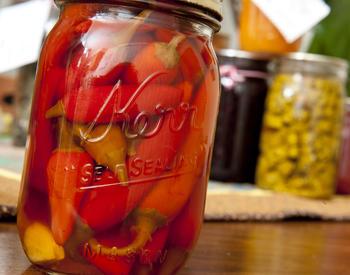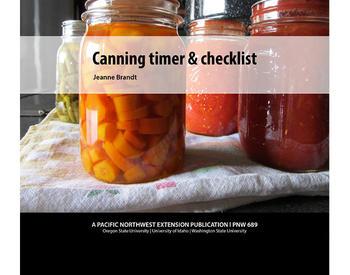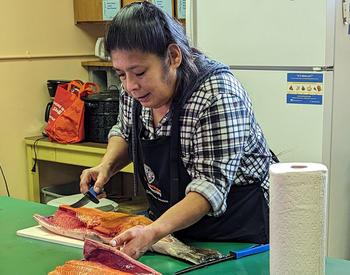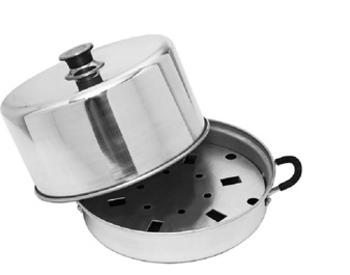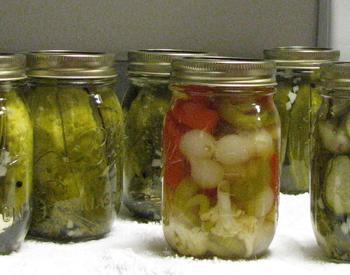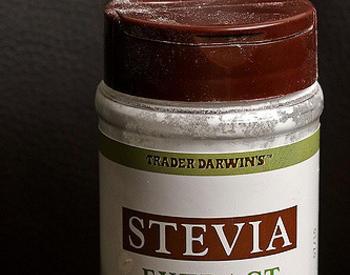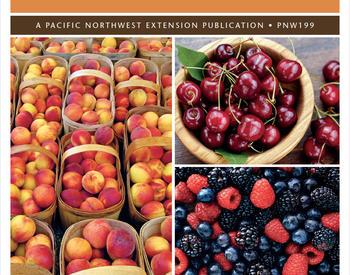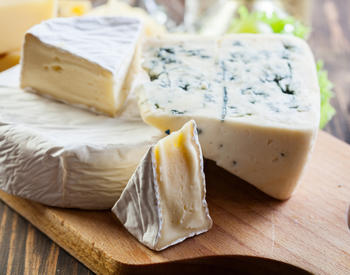Download this publication as a PDF
Canning
Tomatoes may be canned by themselves or in combination with other vegetables or meat (such as salsa, sauces, catsup or spaghetti sauce).
It’s important to use safe procedures when canning tomatoes and tomato products. Laboratory-tested methods must be used to destroy microorganisms that cause spoilage. Refer to these two publications that are available online or through county Extension offices:
Here are some additional ideas if you have an abundance of tomatoes.
Tomato catsup
Yield: 6–7 pints
- 24 lbs. ripe tomatoes
- 3 sticks cinnamon, crushed
- 3 cups chopped onions
- 1½ tsp. whole allspice
- ¾ tsp. ground red pepper (cayenne)
- 3 Tbsp. celery seeds
- 3 cups cider vinegar (5%)
- 1½ cups sugar
- 4 tsp. whole cloves
- ¼ cup salt
Procedure:
- Wash tomatoes. Dip in boiling water for 30 to 60 seconds or until skins split.
- Dip in cold water. Slip off skins and remove cores.
- Quarter tomatoes into 4-gallon stock pot or a large kettle. Add onions and red pepper.
- Bring to boil and simmer 20 minutes, uncovered.
- Combine spices in a spice bag and add vinegar in a 2-quart saucepan. Bring to boil. Turn off heat and let stand 20 minutes.
- Remove spice bag and combine vinegar and tomato mixture. Boil about 30 minutes.
- Press boiled mixture through a food mill sieve. Return to pot.
- Add sugar and salt, boil gently and stir frequently until volume is reduced by one-half or until mixture rounds up on spoon without separation.
- Fill pint jars, leaving ⅛-inch head space.
- Adjust lids and process pints or ½ pints in a boiling water bath:
- Altitude 1,000 ft and below: 15 minutes
- Altitude 1,001–6,000 ft: 20 minutes
- Altitude over 6,000 ft: 25 minutes
- After processing, take canner off heat. Remove lid. Wait 5 minutes before removing jars.
Tomato paste
Yield: about 8 or 9 half-pint jars
- 14 pounds Roma- or paste-type tomatoes (as purchased)
- 1 teaspoon canning or pickling salt (optional)
- 2 bay leaves (optional)
- 1 teaspoon citric acid
- 1 clove garlic (optional)
Hot pack procedure:
- Rinse tomatoes thoroughly under running water and remove cores; do not peel. Chop tomatoes into ½- to ¾-inch pieces.
- Place in stockpot; cover and bring tomatoes to a boil. Stir as needed to prevent burning. Reduce heat, remove lid and cook slowly (simmer) for about 1 hour until volume is reduced by half.
- Stir frequently to prevent sticking and burning. Press through a fine sieve (or food mill with fine blade). NOTE: Do not use a blender or food processor, as these will incorporate undesired air into the tomatoes.
- Return sieved tomatoes to stockpot. Stir in citric acid thoroughly. Add and stir in any or all of salt, bay leaves and garlic clove (if desired).
- Continue cooking slowly on medium heat, uncovered, until thick enough to round up on a spoon and volume is reduced again by half (about 2½ hours).
- Stir frequently to prevent sticking and burning. Be careful of spattering, which could burn your skin as you stir. Remove bay leaves and garlic clove if used.
- Fill hot paste in clean, hot half-pint jars, leaving ½-inch headspace. Remove air bubbles and adjust headspace if needed.
- Wipe jar rims with a clean dampened paper towel. Adjust lids.
- Process half-pint jars in a boiling water bath
- Altitude 1,000 ft or below: 45 minutes
- Altitude 1,001–3,000 ft: 50 minutes
- Altitude 3,001–6,000 ft: 55 minutes
- Altitude over 6,000 ft: 60 minutes
- After processing, turn off heat. Remove canner lid. Wait 5 minutes before removing jars.
Spicy chili sauce
Yield: About 6 pints
- 4 quarts peeled, cored, chopped red-ripe tomatoes (about 24 large)
- 1 tablespoon salt
- 1 tablespoon celery seed
- 2 cups chopped onions
- 1 teaspoon ground allspice
- 1½–2 cups chopped sweet green peppers (about 3 medium)
- 1 teaspoon ground cloves
- 1 teaspoon ground cinnamon
- 1½ cups sugar
- 1 teaspoon ground ginger
- 1 to 1½ cups vinegar
Procedure:
- Combine all ingredients. Bring to a boil; simmer until thick as desired (about 2 to 2½ hours). Stir frequently to prevent sticking.
- Pour hot sauce into jars, leaving ½ inch head space.
- Wipe jar rims. Adjust lids.
- Process half-pint or pint jars in a boiling water bath (212°F):
- Altitude 1,000 ft or below: 15 minutes
- Altitude 1,001–6,000 ft: 20 minutes
- Altitude over 6,000 ft: 25 minutes
- After processing, turn off heat. Remove canner lid. Wait 5 minutes before removing jars.
Two-in-one barbecue sauce
Yield: makes about 6 pints
- 16 cups puréed seeded peeled plum tomatoes (see tips at bottom)
- 2¼ cups puréed seeded green bell peppers (see tips at bottom)
- 2 cups puréed onions (see tips at bottom)
- 3 cloves garlic, finely chopped
- 2 Tbsp. mustard seeds, crushed
- 1 Tbsp. celery seeds
- 2 dried chili peppers, seeded and crushed
- Stampede-style sauce
- ¾ cup mild-flavored or fancy molasses
- ¾ cup malt vinegar
- 1/3 cup Worcestershire sauce
- 2 Tbsp. chili powder
- 2 tsp. freshly ground black pepper
- Sweet 'n' sour sauce
- 1 Tbsp. finely chopped ginger root
- ¾ cup liquid honey
- ¾ cup cider vinegar
- ½ cup soy sauce
- 2 cups canned crushed pineapple, with juice
Procedure:
- To a large stainless steel saucepan, add half of the tomato purée. Over high heat, stirring frequently, bring to a full rolling boil. While maintaining the boil, gradually add remaining purée. Cook over high heat, stirring frequently until reduced by half, about 1 hour.
- Add puréed green peppers and onions, garlic, mustard seeds, celery seeds and chili peppers. Return to a boil over high heat.
- Reduce heat to medium and boil gently, stirring frequently, until peppers and onions are tender about 10 minutes.
- Divide mixture equally between two stainless steel saucepans.
- Add ingredients for stampede-style sauce to one pan; ingredients for the sweet 'n' sour sauce to the other. (If you prefer, you can double the ingredients of one variety and make six jars of that). Bring both mixtures to a boil over high heat, stirring frequently.
- Reduce heat and boil gently, stirring frequently, until mixtures are thickened to the consistency of a thin commercial barbecue sauce, about 45 minutes.
- Meanwhile, prepare canner, jars and lids.
- Ladle hot sauces into hot jars, leaving ½ inch headspace. Remove air bubbles and adjust headspace, if necessary, by adding hot sauce.
- Wipe rim. Center lid on jar. Screw band down until resistance is met, then increase to fingertip-tight.
- Place jars in canner, ensuring they are completely covered with water. Bring to a boil and process:
- Altitude 6,000 ft and below: 20 minutes
- Altitude over 6,000 ft: 25 minutes
- Remove canner lid. Wait 5 minutes, then remove jars, cool and store.
Tips
- To seed tomatoes, cut them in half and squeeze out seeds or scoop them out with a spoon or your fingers.
- To purée tomatoes, either press them through a food mill or purée them in a blender or food processor after they have been peeled and seeded. Use a food processor to purée the green pepper and onion.
SOURCE: Ball Complete Book of Home Preserving, Kingery and Devine, 2006 Jarden Corporation. Page 262.
Green tomato pie filling
Yield: About 7 quarts
- 4 qts. chopped green tomatoes
- 2½ cups white sugar
- 3 qts. peeled and chopped tart apples
- ½ cup vinegar (5%)
- 1 lb. dark seedless raisins
- 1 cup bottled lemon juice
- 1 lb. white raisins
- 2 Tbsp. ground cinnamon
- ¼ cup minced citron, lemon or orange peel
- 1 tsp. ground nutmeg
- 2 cups water
- 1 tsp. ground cloves
- 2½ cups brown sugar
Procedure:
- Combine all ingredients in a large saucepan. Cook slowly, stirring often, until tender and slightly thickened (about 35 to 40 minutes).
- Fill jars with hot mixture, leaving ½-inch head space.
- Adjust lids and process for 15 minutes in a boiling water bath.
- Altitude 1,000 ft or below: 15 minutes
- Altitude 1,001–6,000 ft: 20 minutes
- Altitude over 6,000 ft: 25 minutes
- After processing, take canner off heat. Remove lid. Wait 5 minutes before removing jars.
Stewed tomatoes
- 2 quarts chopped tomatoes
- ¼ cup chopped green pepper
- ¼ cup chopped onion
- 2 teaspoons celery salt
- 2 teaspoons sugar
- ¼ teaspoon salt
Procedure:
- Wash tomatoes. Dip in boiling water for 30 to 60 seconds or until skins split. Dip in cold water. Slip off skins and remove cores.
- Combine all ingredients. Cover and cook 10 minutes, stirring occasionally to prevent sticking.
- Pour hot into hot jars leaving ½-inch head space. Remove air bubbles.
- Wipe rims. Adjust lids and process. Process pints 15 minutes; quarts 20 minutes. Use dial gauge canner or weighted gauge canner:
- Weighted gauge:
- 10 pounds up to 1,000 ft altitude
- 15 pounds over 1,000 ft altitude
- Dial gauge:
- 11 pounds up to 2,000 ft altitude
- 12 pounds from 2,001–4,000 ft altitude
- 13 pounds from 4,001–6,000 ft altitude
- 14 pounds for over 6,000 ft altitude
- Weighted gauge:
- After processing, turn off heat. Remove canner lid. Wait 5 minutes before removing jars.
Source: The previous recipes are from So Easy To Preserve, 6th Edition, Cooperative Extension/ The University of Georgia/Athens unless otherwise noted.
Freezing
Tomatoes may be frozen. They’re best when frozen whole, with skins on or removed (when slightly thawed, tomatoes pop out of their skins). Paste-style tomatoes freeze best whole.
Tomatoes can also be frozen stewed or pureed. Select ripe tomatoes free from blemishes. Remove stem ends, peel and quarter. Cook until tender. Cool by setting container in a pan of cold water. Pack into containers suitable for freezing.
For further information, refer to Freezing Fruits and Vegetables.
Drying
Select ripe tomatoes of good color (meaty varieties work the best). Remove skins, if desired, by dipping in boiling water for 30 seconds. Chill in cold water.
Cut tomatoes into ¼- to ⅓-inch slices.
Note: If tomatoes blacken, heat slices first by steaming, blanching or heating in a microwave until heated throughout, but not cooked.
Place on dehydrator trays. For seasoned tomatoes, sprinkle fresh slices with dried oregano, basil and/or garlic powder.
Dry until leathery and crisp. Store dried tomatoes in a cool, dry, dark place in plastic or glass containers.
Pizza leather
- 1 can (15 oz.) stewed tomatoes, drained
- 1 can (8 oz.) tomato sauce
- 1 teaspoon sugar (optional)
- Leaf oregano
- Leaf basil
- Garlic salt
Procedure
- Drain liquid from tomatoes. Blend drained tomatoes, tomato sauce and sugar in a blender until smooth.
- Pour tomato puree on a plastic wrap-lined drying tray. Sprinkle oregano, basil and garlic salt on top of puree. Dry 4–6 hours until leather is dry and no longer tacky.
- Pizza leather makes a great snack served with a square of cheese and sausage or ham. It can also be rehydrated and added to spaghetti sauces, Swiss steak, etc.
Dried tomatoes in oil
Because of their acidity, unseasoned (i.e., no vegetables or herbs) fully dried tomatoes may be safely stored in oil at room temperature. (Refrigeration may delay rancidity, however). The tomatoes will soften more if quickly dipped in bottled lemon or lime juice before being placed in the oil. The tomatoes can be flavored with dried herbs and garlic.
NOTE: Dried tomatoes-in-oil mixtures with garlic and/or herbs MUST be refrigerated and used within 4 days or frozen for long-term storage.
Dried tomatoes in oil can be used on pizza, pasta salads, appetizers and Italian dishes. The oil can be used in vinaigrette dressing or in a marinade sauce. It can also be used as a dip for French bread.
Related Articles
Source: OSU Master Food Preserver Program
